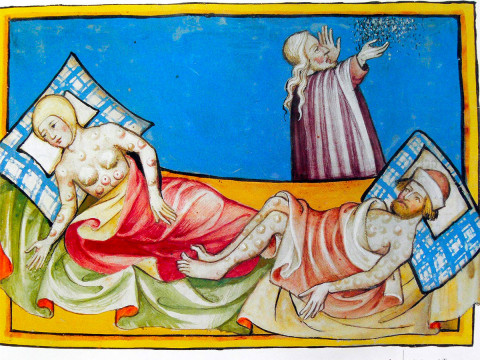“Black Death” or the “Bubonic Plague” was one among the deadliest outbreaks within the history of the planet Earth. In the mid-1300s (1346-1353), when most of the medical systems were based not on scientific facts but wrongly believed rituals, which did not yield any results did not help much in treatment or finding a cure for the disease. Many deaths occurred, leading up to 25 million deaths which were recorded.
Where did the Bubonic Plague originate?
The plague is believed to have originated in Asia about more than 2,000 years ago. Even before the outbreak of the bubonic plague in Europe, the Europeans had heard about the “Great Pestilence” (Bubonic Plague) wreaking havoc in countries like China, India and Egypt. The plague was most likely, spread through the trading ships travelling all around the globe. The situation was similar to the one it is today. Earlier, in the 1300s the trading ships spread the plague globally and today, coronavirus is being spread through air travel, water travel and land travel though at a much faster pace due to modernization of the world.
How did the Bubonic Plague spread in Europe?
The Bubonic Plague is believed to have spread through the “Death Ships”. The “Death Ships” were actually 12 ships which had docked on the Sicilian port of Messina. The people who were waiting for the ships to arrive also saw the horrors awaiting them. Expecting to find cheerfully waving sailors, they instead found that most of the sailors aboard had died due to some mysterious malady and those few who were alive seemed to be covered in black boils which were oozing pus and blood.
How did the Bubonic Plague spread so widely in such a short period of time?
This question has pestered many people. At first even scientists found it difficult to answer. But research showed that Bubonic Plague was able to spread so quickly because the discovery of the ships allowed the infected rodents to escape the confines of the ships. Also, the people who surveyed and came in contact with the sailors were infected as Bubonic Plague is spread by touching the infected person and flea bites.
Literature on the Bubonic Plague
Every child around the world has heard this poem:
“Ring around the Rosie,
Pocket full of Poesy,
Ashes, Ashes we all fall down.”
This is a very famous nursery poem. But it has a gruesome meaning. Each line of the poem depicts different scenarios, which are all regarding the times of Bubonic Plague.
- “Ring around the Rosie.”
This line tells us that the infected people developed boils on their bodies which had a central dark spot in them. That is why the boils have been described as “Rosie” or roses.
- “Pocket full of Poesy.”
This line tells us that due to so many deaths, the stench sometimes seemed overpowering to people. So as to cover the smell of death, people carried posies and flowers in their pockets.
- “Ashes, Ashes we all fall down.”
Due to fear of the plague, uninfected people tended to burn the infected people or burn the houses in which they lived. This became such a widespread practice that whole villages were burned down to ashes. That is why ashes had become a common sight during those times.
Why was the Bubonic Plague considered “God’s Punishment”?
To cope with the uncertainty that was brought by the new plague, many people believed that the plague was god’s way for taking retribution against sins committed by the human race such as greed, blasphemy and worldliness.
Thousands of Jews were massacred in a bid to satisfy God. To escape people of other religions, the Jews fled to sparsely populated areas such as Eastern Europe.
Who were the Flagellants?
Some upper- class men also joined the “Flagellants”, processions of which went from town to town and publicly displayed acts of penance and punishment. They hit themselves with whips, Stone edged lashes and people in all the towns witnessed and encouraged the gore and blood being shed daily in the streets in hopes that the Plague would magically disappear or a cure would be found.
How did the Bubonic Plague end?
The people at that time(1300s) were not advanced scientifically. But people were able to observe that the plague spread through touching the infected people. So, some forward-thinking officials in Venetian barred sailors who came to travel anywhere until they proved that they were not infected by the disease. They were made to stay in the ships only. This practice led to the birth of “Quarantino” or the popular term used today known as “Quarantine”. The dead bodies of the infected people were buried in mass graves and the homes were people infected with the plague lived were marked with a bale of hay strung on a pole outside. If a person had infected family members, then he or she had to carry a white pole when going out in public. Thousands of cats and dogs were also massacred because they were believed to carry and spread the plague. As cruel and merciless these methods seem to be, they were nevertheless effective in stopping the outbreak.
Is there a cure for the Bubonic Plague?
Yes, there is a cure for the Bubonic Plague. The Bubonic Plague is caused by a bacillus Yersina Pestis. The Bubonic Plague can be treated through a number of antibiotics. This treatment has proved to lower the mortality rate by 11%. The antibiotics show the best results when the patient is treated with them during the first 24 hours.

By Ananya Jain, Indirapuram, Uttar Pradesh










